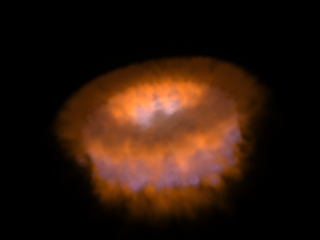The Case of the Massive Forming Star
Disk and Outflow Theory
Currently, astronomers believe that the disk and outflow model is the best "fit" to their data for Source I. (See their actual data.) The data show bands of maser emission forming an X on the sky, which move gradually away from the center, month to month, achieving speeds of about 50,000 miles per hour!
Astronomers also measure small shifts in the frequency of radiation caused by motion toward us and away from us. This is known as the Doppler shift, named after Austrian physicist Christian Doppler, who proposed it in 1842, in a discussion of star light. Motion towards us shifts radiation to a higher frequency, making it "more blue." Motion away from us makes radiation "more red." Around Source I, emission is bluer on one side and redder on the other. This indicates that material material in the outflow is not just moving away from the star, but is actually spiraling as it moves, like the reverse of water going down a drain.
Not all of the maser emission lies in the X, providing evidence of more that just outflow. Additional maser emission outlines a bridge that joins two arms of the X, with gas flowing back and forth along the bridge. The best explanation thus far is that the masers trace the edges of a disk seen almost entirely side-on. The back and forth motions reflect the disk's rotation as material orbits around the central young star. In this artist's illustration, the motion in the disk and the outflow are scaled to the actual observations. One year in the life of the disk is about 100 Earth years.








